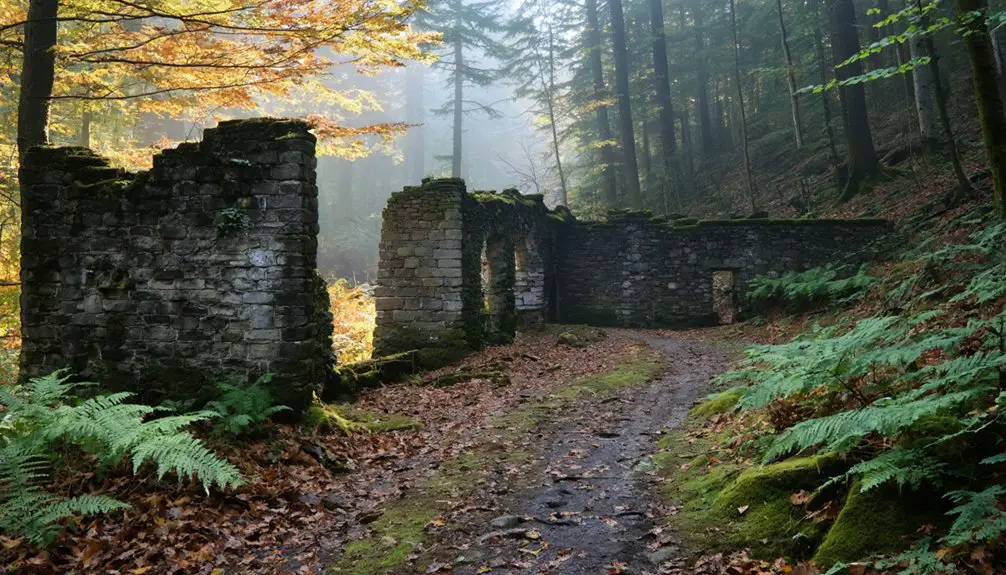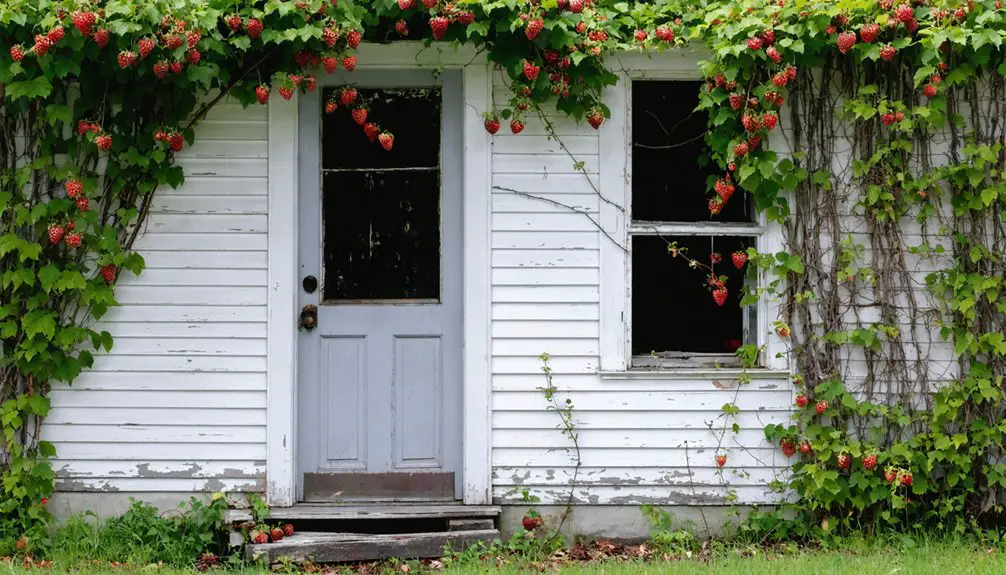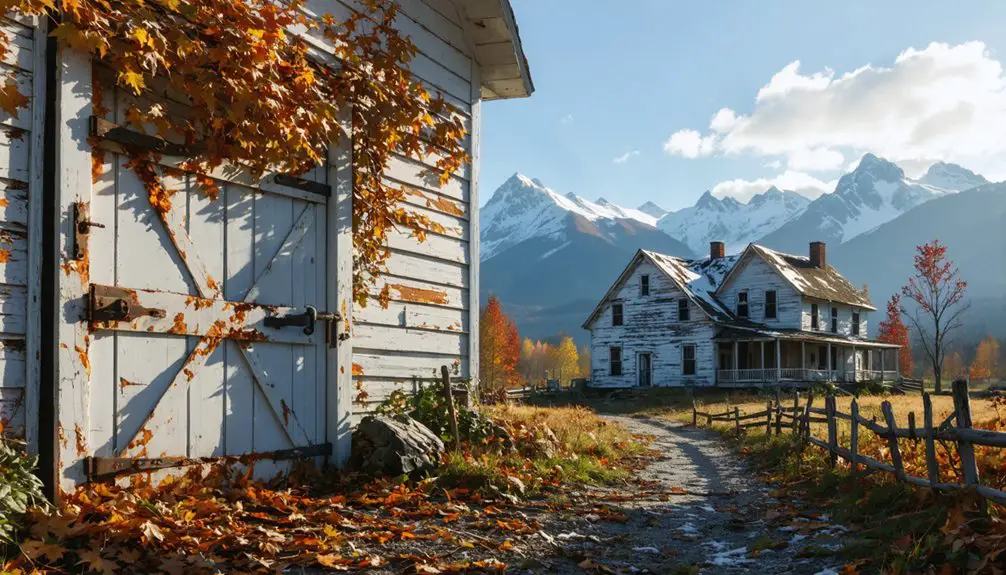You’ll find Winhall’s ghost town story began in 1761 when New Hampshire granted its charter. After Nathaniel Brown established the first farm in 1780, the town grew steadily through logging operations, peaking at 842 residents in the 1870s. Intensive deforestation and poor soil conditions triggered a dramatic population decline, falling to just 229 people by 1930. While Bondville village survived, much of Winhall’s original settlement holds untold stories in its abandoned landscapes.
Key Takeaways
- Population plummeted from 842 residents in 1870s to 229 by 1930, marking a dramatic decline similar to other Vermont ghost towns.
- Deforestation and poor soil quality forced many residents to abandon farms, leading to widespread property abandonment.
- Bondville remains one of the few populated areas in Winhall, while many other sections became deserted.
- Unsustainable logging practices depleted natural resources, causing economic collapse and mass exodus of residents.
- Early settlement challenges, including harsh winters and isolation, contributed to the town’s eventual near-abandonment status.
Origins and Early Settlement
While many Vermont towns were established in the mid-18th century, Winhall’s official charter came on September 15, 1761, when New Hampshire’s Governor Benning Wentworth granted 68 shares of land to Osee Webster and 61 others.
The town’s name cleverly combined two original proprietors, Winn and Hall, reflecting the entrepreneurial spirit of these early landowners.
Early Vermont settlers memorialized their entrepreneurial ambitions through place names, as seen in Winhall’s portmanteau of two founding proprietors.
Despite contested territory claims between New Hampshire and New York, settler motivations remained strong during the Revolutionary War period.
Nathaniel Brown became the first settler in 1780, establishing a farm that would later be deeded to Joshua Barnard.
You’ll find that land disputes didn’t deter these pioneers, though they faced significant challenges. The rough terrain and poor soil quality limited agricultural prospects, influencing how densely the town developed.
Like many Vermont ghost towns such as Somerset, the area experienced a significant population peak in the 1880s during logging operations.
From Thriving Village to Abandonment
You’ll find that Winhall’s early prosperity masked an unsustainable dependence on timber resources, with the town’s population never exceeding 400 people even at its peak.
Similar to the abandoned graveyard site near Starksboro that now sits quietly hidden along unmaintained trails, Winhall gradually faded into Vermont’s historical landscape.
The intense logging operations quickly depleted the surrounding forests, leaving residents with diminishing economic opportunities in the isolated mountain setting.
The town experienced a similar fate to Somerset, where deforestation and timber depletion led to a dramatic population decline and eventual abandonment of the area.
Settlers Face Harsh Reality
Despite Winhall’s initial promise as a settlement, the stark realities of Vermont’s mountainous terrain quickly tested the resolve of its earliest inhabitants.
You’d have found survival strategies severely limited by rocky soil that fought against your plow and growing seasons so short they’d dash your farming hopes. The isolation effects wore you down as harsh winters cut you off from neighboring communities for months at a time.
If you’d settled in Winhall, you’d have faced the brutal challenge of clearing dense forests just to create farmland, only to discover that the soil beneath couldn’t sustain your crops. Like many who sought utopian communities in Vermont’s challenging landscape, the dream of self-sufficiency collided with harsh natural conditions.
Your livestock struggled against the elements, and when food grew scarce, strict rationing at local poor farms reminded you just how precarious life had become in this unforgiving landscape. Many residents had to rely on the poorhouses and farms established under Vermont’s 1797 law requiring local governments to support those in need.
Early Population Steadily Declines
As Winhall entered the 1870s with a peak population of 842 residents, few could have predicted the dramatic decline that lay ahead. The town’s population trends took a sharp downturn, falling 14.3% by 1880 and plummeting another 27.6% to 523 residents by 1890.
You’d have witnessed a continuous exodus over the next four decades as economic shifts and resource depletion took their toll. The town’s Bondville village area remained one of the few populated centers during this period. By 1930, only 229 people called Winhall home – a shadow of its former liveliness.
While a slight rebound brought the count to 255 by 1950, the town struggled to maintain even modest growth. The community remained largely dormant through the mid-20th century, with population levels hovering between 200 and 300 residents until the 1970s began a new chapter. A remarkable turnaround would eventually occur, with the population reaching 1,187 peak residents in 2021.
Geographical Features and Boundaries

Northeastern Bennington County serves as the scenic home of Winhall, Vermont, a town spanning 44 square miles of mainly mountainous terrain.
You’ll find this Green Mountain community resting at an elevation of 1,798 feet, where distinctive topographical features shape its rugged landscape. The unincorporated village of Bondville anchors the southeast corner, while Stratton Mountain Resort partly extends into the southern region. The village area is centered around 115 Vermont Route 30, which serves as the town’s main thoroughfare.
Nestled in Vermont’s Green Mountains, Winhall’s rugged terrain features Bondville village and part of the renowned Stratton Mountain Resort.
The town’s boundaries tell an intriguing story of early surveying mishaps. When surveyors mistakenly started at Stratton’s northeast corner instead of Manchester’s southeast corner, they created notable boundary anomalies.
Today, you’ll see Winhall’s borders touch Peru to the north, Jamaica and Londonderry to the east, Stratton to the south, and Manchester to the west, where an unusual gore of land marks this historic error.
Preservation of Historical Records
Three major repositories safeguard Winhall’s historical legacy today: FamilySearch’s digital archives, the Town Clerk’s office, and the Vermont Historical Society.
You’ll find essential records spanning 1850-2005, including births, deaths, and marriages, all accessible through these institutions’ record preservation efforts.
If you’re researching Winhall’s past, you’ve got both digital and physical archival access options. The Town Clerk maintains original documents for in-person viewing or mail requests, while digital repositories help protect fragile materials through reduced handling. Like Milton Co-operative Dairy’s early shipping records, these archives provide crucial documentation of Vermont’s agricultural development.
You’ll discover town reports, historical maps, photographs, and period documents that paint a complete picture of Winhall’s history. The preservation approach combines official records with local folklore, ensuring both tangible and intangible heritage survives for future generations.
Cultural Legacy and Communal Movements

You’ll find that Winhall’s cultural legacy extends beyond its ghost town associations through various counter-cultural movements that emerged in the 1960s and 1970s, including experimental farming communes and self-sufficiency initiatives.
Several Buddhist retreats and meditation centers established themselves in the area’s abandoned properties, transforming former homesteads into spaces for spiritual practice and alternative living.
These communities have contributed to Winhall’s evolving identity, blending traditional Vermont values with progressive social experiments and sustainable living practices.
Counter-Cultural Living Experiments
During the 1960s and 1970s, Winhall and surrounding Vermont ghost towns became magnets for counter-cultural living experiments, as hippies and spiritual seekers established intentional communities in these remote mountain regions.
You’ll find that these alternative lifestyles flourished in areas like Bondville, where abandoned settlements provided the perfect backdrop for communal resilience and experimental living.
- The Tail of the Tiger Commune near Winhall exemplified this movement, combining Tibetan Buddhist practices with collective decision-making.
- Communities adopted Eastern philosophies and meditation, rejecting mainstream capitalism in favor of shared resources.
- Natural isolation and rugged terrain offered the seclusion these groups sought, though it also presented significant challenges to sustainability.
These experimental communities helped shape Vermont’s enduring identity as a haven for those seeking freedom from conventional society.
Farming and Self-Sufficiency Practices
The roots of Winhall’s farming legacy stretch back to its origins as a “poor farm,” where indigent residents worked the land in exchange for basic necessities.
This foundation of agricultural resilience shaped generations of farmers who embraced sustainable practices through mixed-use farming and local resource utilization.
Buddhist and Alternative Communities
While Vermont’s rural landscape provided fertile ground for traditional farming, it also attracted diverse spiritual movements seeking solitude and connection to nature.
Buddhist communities and alternative lifestyles found their home in the Green Mountain State, establishing centers of meditation, healing, and communal living.
- Tail of the Tiger Commune in Barnet emerged as a pioneering Tibetan Buddhist community, blending meditation practices with craft businesses and therapeutic activities.
- Sunray Peace Village created a unique fusion of Native American and Buddhist traditions on its 27-acre Mountain Meadows site, maintaining monthly ceremonial fires and prayers.
- The Vermont Zen Center, founded in 1988, grew from a modest home practice into a full-fledged center with dormitories and meditation halls, focusing on personal liberation and social outreach.
These spiritual communities have enriched Vermont’s cultural tapestry, offering alternatives to conventional living while preserving ancient wisdom traditions.
The Rise of Bondville
As Vermont’s rural communities expanded in the late 18th century, Bondville emerged as an essential settlement at the crossroads of what would become Routes 100 and 30.
You’ll find that Bondville’s development accelerated after 1888 when it received its post office, named after the first postmaster.
While other early Winhall settlements faded away, Bondville’s strategic location at 1,250 feet elevation made it the town’s enduring hub.
The economic transformation of the area centered on forestry and lumber industries, with several sawmills, a grist mill, and a chair factory driving prosperity.
The village boasted a Methodist church and hotel, serving as the commercial heart of Winhall.
Even as the town’s population declined after the 1870s, Bondville remained the only significant village in the area.
Frequently Asked Questions
Are There Any Remaining Structures or Ruins Visible in Winhall Today?
When you explore deep into the hills, you’ll discover remaining buildings scattered along old carriage roads, including partially standing foundations and ruins that carry historical significance from early 1800s settlement patterns.
What Natural Disasters or Events Contributed to Winhall’s Abandonment?
You won’t find major natural disasters behind the abandonment – it wasn’t flood damage that killed this town. Instead, you’ll see the gradual economic decline from depleted logging resources sealed its fate.
How Safe Is It to Explore the Ghost Town Area?
You’re gambling with danger! While ghost town exploration can be thrilling, you’ll need strict safety guidelines: avoid unstable structures, watch for sinkholes, bring navigation tools, and don’t explore alone.
What Artifacts Have Been Discovered in the Abandoned Settlement Areas?
You’ll find stone toolmaking debris, ceramic pottery fragments, industrial kiln ruins, and unique personal items. Artifacts analysis reveals significant historical significance through quartzite flakes, charcoal production sites, and repurposed household materials.
Are There Any Ghost Stories or Legends Associated With Winhall?
While you might hear whispers of Bennington Triangle mysteries nearby, there aren’t any documented Winhall hauntings or legends. The town’s ghost stories blend into broader regional folklore rather than specific local tales.
References
- https://www.familysearch.org/en/wiki/Winhall
- https://www.instagram.com/reel/DBqvoTHO7Ck/
- https://sites.rootsweb.com/~vermont/BenningtonWinhall.html
- https://en.wikipedia.org/wiki/List_of_ghost_towns_in_Vermont
- https://vermonthistory.org/back-to-the-land-communes-in-vt-1968
- https://obscurevermont.com/tag/ghost-town/
- https://www.vermontpublic.org/programs/2018-08-03/a-brief-history-of-vermont-road-names
- https://obscurevermont.com/tag/somerset/
- https://www.youtube.com/watch?v=ScW-H7A8yL8
- https://vermonthistory.org/journal/misc/ForestInEveryTown.pdf



